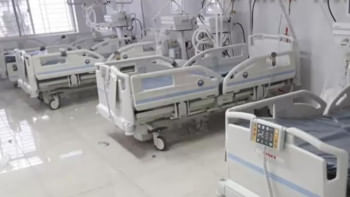Demand for ICU beds on the rise
As the number of Covid-19 infections has been rising since November, the demand for ICU beds at hospitals in the capital has almost doubled.
In Chattogram city, the same trend was also noticed.
Physicians said the number of critical patients is increasing, while public health experts said it is happening due to the rising number of infections with the arrival of winter.
In the week from December 10, on an average 62 ICU beds remained vacant daily in 19 Covid-19 hospitals or hospital units in Dhaka city, according to the information based on press releases of the Directorate General of Health Services.

During the same period last month (November 10-16), the average number of ICU bed vacancy was 119 daily.
There are a total of 288 ICU beds in the Covid-19 dedicated hospitals in Dhaka city. Of them, 113 are in 10 government hospitals and 175 in nine private facilities.
During the seven-day period from December 3-9, 82 ICU beds remained vacant daily, on average.
It indicates that the demand for ICU beds to handle the critical patients is increasing gradually.
In Chattogram city, the increasing trend of critical patients is a bit lower than that of Dhaka city. There are seven Covid-19 hospitals, which have 45 ICU beds.
In the last one week, on an average 22 ICU beds were vacant daily while it was 27 daily during the same days in November.
Dr MA Hasnat, an assistant professor of cardiology at Kurmitola General Hospital, the first Covid-19 dedicated hospital in the country, told The Daily Star, "The number of patients decreased earlier [two months ago]. Now we observe it is increasing. The number of critical patients who require ICU treatment is going up.
"We are getting more critical patients this time than we got at the onset of the Covid-19 outbreak [in the country]. Covid-19 patients do not come to hospital unless they feel severe [illness]," he added.

NEW DEATHS
Meanwhile, 27 more Covid-19 patients died in 24 hours ending 8:00am yesterday, says a DGHS press release.
With this, the total number of deaths reached 7,156, and the death rate was 1.44 percent.
In the same 24 hours, 1,632 new infections were recorded, taking the number of people infected to 4,95,841, said the release.
Against a total of 17,025 tests in those 24 hours, the positivity rate was 9.59 percent, and the overall positivity rate was 16.40 percent.
Positivity rate is one of the important parameters to measure the level of viral transmission, according to epidemiologists.
A positivity rate over five percent means the transmission is not under control.
Since the first Covid-19 case was detected in the country on March 8, the daily positivity rate was comparatively lower, but it rose to 25 percent of those tested in late May.
Until the third week of August, the positivity rate was over 20 percent, which came down to 10 percent in October.
Since the beginning of November, the positivity rate started rising again and rose to the highest 16.43 percent in the last two months.

Dr Mushtaq Hussain, consultant of the Institute of Epidemiology, Disease Control and Research (IEDCR), told this correspondent, "Usually the number of critical patients requiring hospital intervention increases three weeks after the infection rises. As infection has started rising, we are observing pressure on the hospitals."
He urged people to wear masks and follow other health rules to stay safe.
In the same 24 hours, 2,622 Covid-19 patients recovered. With this, the number of recoveries reached 4,23,845, and the recovery rate was 86.09 percent.
Of the 27 deceased, 23 were male and four female.
One was aged between 31 and 40, two were aged between 41 and 50, six between 51 and 60, and 18 were above 60 years, added the release.


 For all latest news, follow The Daily Star's Google News channel.
For all latest news, follow The Daily Star's Google News channel. 



Comments